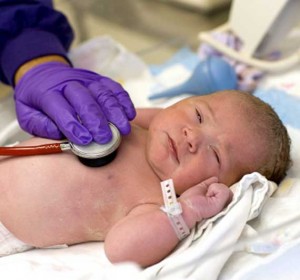If diabetes is managed
well, most problems can be
prevented.The first trimester of your pregnancy, the first 12 weeks, is when your baby’s major organs develop. Because gestational diabetes usually happens after the second trimester, usually between 24 and 28 weeks, your baby is not at a higher risk for birth defects.
However, your baby could have other problems if you don’t treat your diabetes condition as you should. The good news is that if you manage your diabetes well, most of the problems listed below can be prevented.
Hypoglycemia is when the levels of sugar in the blood are too low. If you have too much sugar in your blood right before or during labor, your baby’s pancreas will make extra insulin to use up the extra sugar he is getting from you. When your baby is born, he will have too much insulin in his body because he is no longer getting extra sugar from you. Too much insulin in his body can cause low blood sugar. If untreated, low blood sugar can cause serious problems for your newborn.
Jaundice is a yellowing of the skin caused from a waste product of red blood cells called bilirubin. While your baby is in your womb, he needs a large supply of red blood cells. Once born, your baby’s liver works to remove the old red blood cells. If your baby’s liver cannot remove the old blood cells, the bilirubin builds up, causing your baby’s skin to look yellow. A small amount of jaundice is common. Also, there are special lights that can be used to help your baby break down the bilirubin. However, in rare cases, too much bilirubin can be poisonous and may cause your baby to need a blood transfusion.
Respiratory distress syndrome is a breathing problem caused when a baby’s lungs have not developed enough for the baby to breathe on his own. It is always a risk for babies that are born too soon. Babies born with breathing problems need special care or machines to help them breathe until they can breathe on their own.
Macrosomia means “large body” and refers to a baby whose body is larger than normal for its age. Mothers with gestational diabetes often have large babies. Because babies get their “food” from their mother’s blood stream. If the “food” contains a lot of sugar, your baby will get more sugar than he needs. Your baby’s body will make extra insulin to use the extra glucose; the extra glucose is stored as fat. As your pregnancy continues, your baby grows bigger and fatter. Delivering a large baby can be hard for both mother and baby. Large babies that are born vaginally may hurt their arms or shoulders or may need forceps or a vacuum to help in the birth. Sometimes the baby can be so large, it cannot be born vaginally. Therefore, a cesarean birth is needed.
If you do a good job managing your diabetes, there’s a good chance your baby won’t have these problems. But if he or she does have a problem after birth, your baby’s doctor and delivery nurses should be able to treat it right away. You baby may be managed by the pediatrician the baby nursery.
More about Gestational Diabetes
• What is Gestational Diabetes?
• How Do I Know If I Have Gestational Diabetes?
• Will My Baby Be Alright?
• Will I Be Alright?
• Managing Your Diabetes
• Tests To Check Your Baby’s Health
• Labor and Delivery
• Can I Get Diabetes Again?
